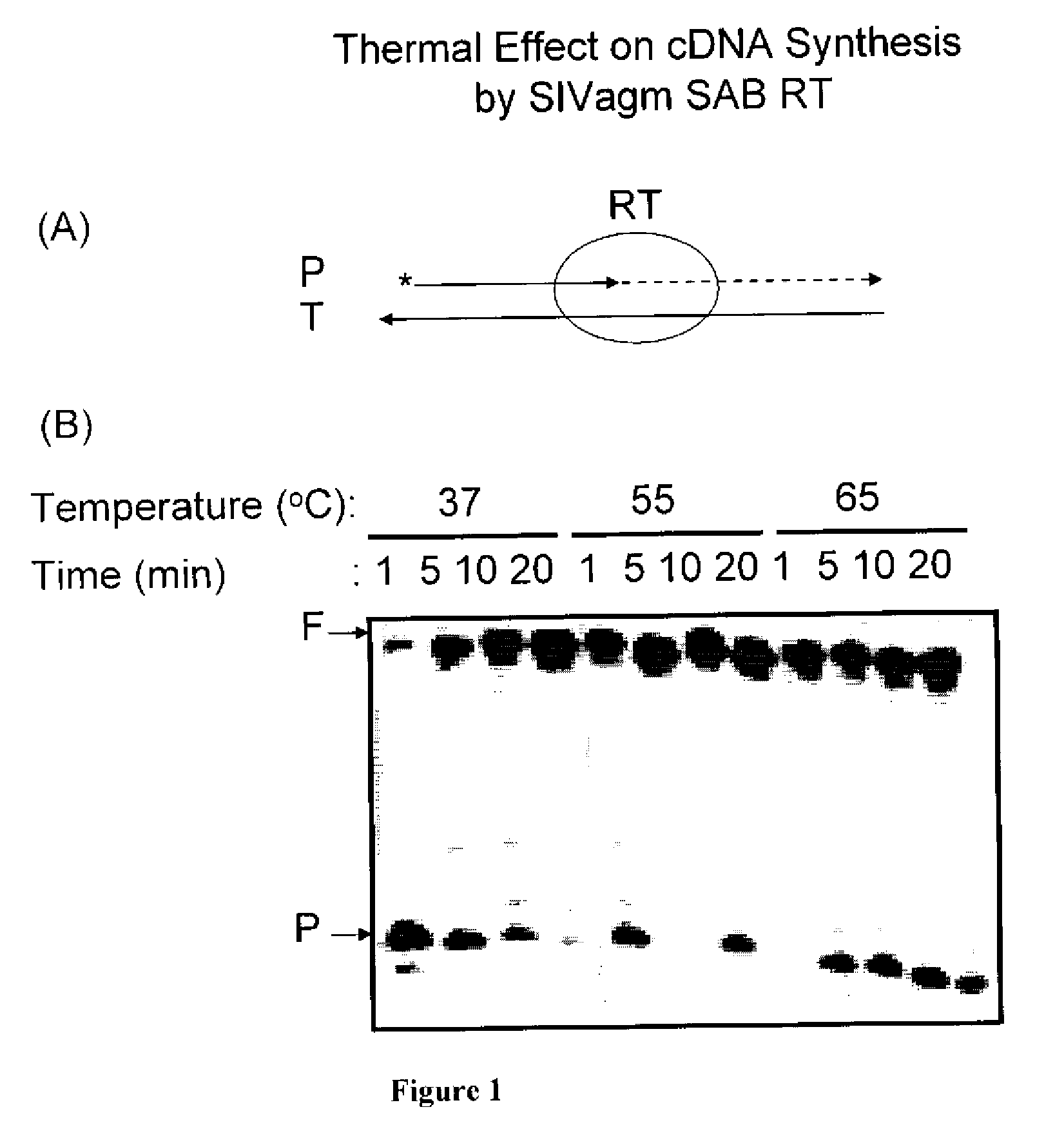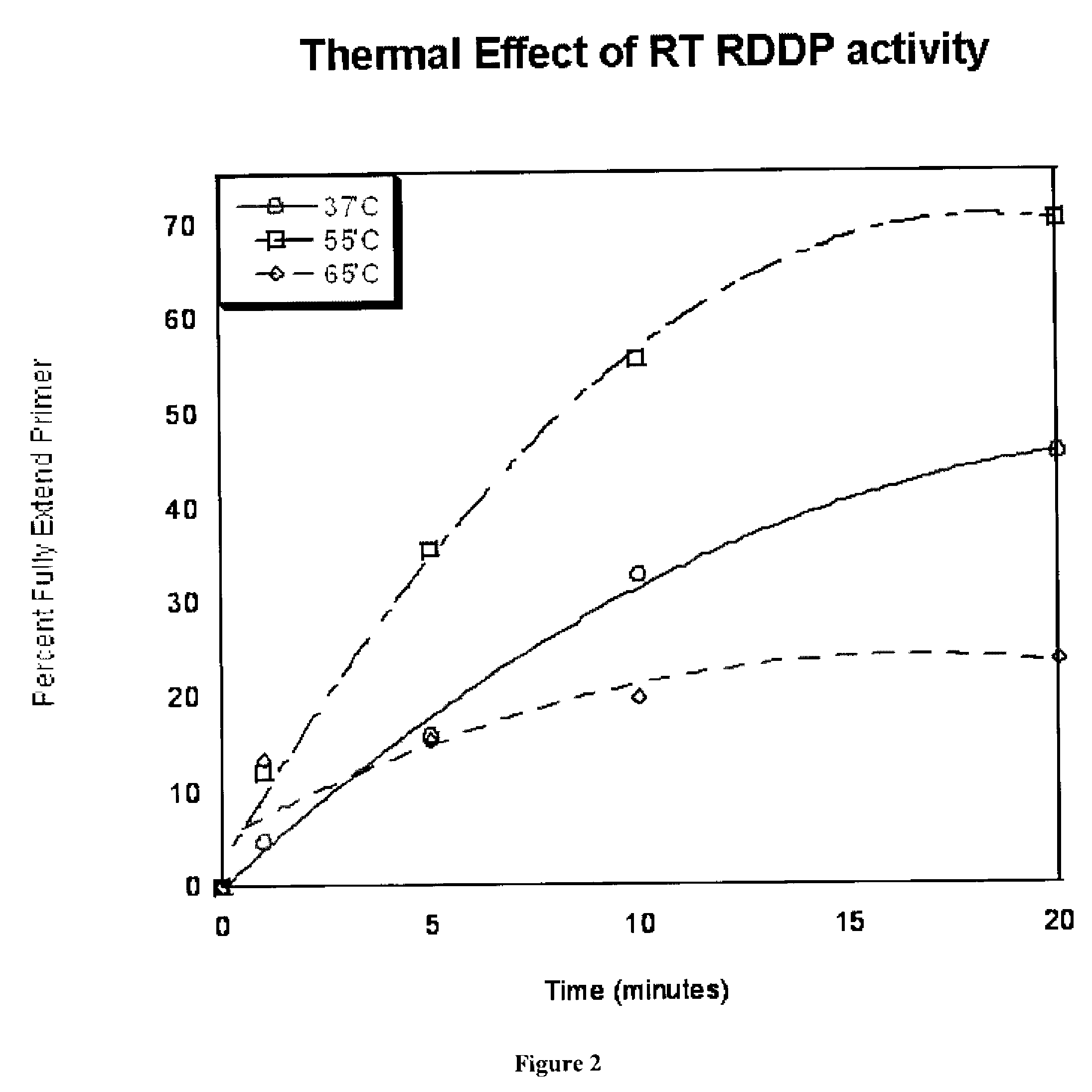THERMOACTIVE SIVagm SAB REVERSE TRANSCRIPTASE
a reverse transcriptase and thermoactive technology, applied in the field of synthesis of dna from rna templates, can solve the problems of high error rate of reverse transcription, interference with the correct analysis of rna molecules, and deleterious aspect of reverse transcription use of rna as templates
- Summary
- Abstract
- Description
- Claims
- Application Information
AI Technical Summary
Benefits of technology
Problems solved by technology
Method used
Image
Examples
example 1
Reverse Transcription Reaction Protocol
[0027]A 38-mer template (5′-GCUUGGCUGCAGAAUAU UGCUAGCGG GAAUUCGGCGCG-3′, concentration 50 nM) was annealed to a 5′ P32 end labeled 23-mer primer (5′-CGCGCCGAATTCCCGCTAGCAAT-3′, concentration=20 nM), was premixed with 4× reaction buffer (100 nM Tris-HCl, pH 8.0, 400 mM KCl, 8 mM DTT, 0.4 mg / ml bovine serum albumin), and 250 mM dNTPs in 18 μL. cDNA synthesis was initiated by adding 2 μl SIVagm SAB RT (25 nM) followed by incubation for 5 min at 55˜60° C. The reaction was terminated by heating at 95° C. for 3 min.
example 2
Thermal Effect on the Reverse Transcription of SIV.agm-sab Reverse Transcriptase
[0028]The primer extension reaction performed is illustrated schematically in FIG. 1(A). A 5′ end 32P-labeled (*) 23-mer primer (P, 5′-CGCGCCGAATTCCCGCTAGCAAT-3′) was annealed the to a 38-mer RNA template (T, 5′-GCUUGGCUGCAGAAUAU UGCUAGCGG GAAUUCGGCGCG-3′: template: primer ratio=2.5:1) and was extended by SIVagm SAB RT. As shown in FIG. 1(B) the T / P was extended by SIVagm SAB RT with 250 mM dNTP at 37, 55 and 65° C., and the reactions were terminated at 1, 5, 10, and 20 min incubations. The reaction products were analyzed by 14% urea-denatuting gel electrophoresis. F: 38 nucleotide long fully extended product, P: 23-mer unextended primer. A plot of the percent of primer fully extended vs. time is shown in FIG. 2.
example 3
Thermal Effect of Reverse Transcriptase Fidelity
[0029]A misincorporation assay with a matched primer was performed as follows: the 32P-labeled 17-mer matched primer (“S”) annealed to a 38-mer RNA template was extended by MuLV RT (15 nM) at 37° C., 45° C., 55° C., and 60° C. for 3 min in the presence of either all four dNTPs or only three complementary dNTPs (minus TTP and minus dCTP). As determined by amounts of the fully extended primer (“F”) in all dNTPs, reverse transcriptase activity of RT was reduced to 65% at 55° C. The sites with “*” indicate the stop sites where the deleted dNTPs would be incorporated into the reactions with only three dNTPs. In the assay with matched primer and only three dNTPs, the higher efficiency of elongation of terminated primer beyond the stop sites reflected the lower fidelity of the reverse transcriptase protein assayed, as is shown in FIG. 3(A).
[0030]An extension of mismatched primer assay was performed as follows: the 32P-labeled 16-mer G / T misma...
PUM
| Property | Measurement | Unit |
|---|---|---|
| temperature | aaaaa | aaaaa |
| temperature | aaaaa | aaaaa |
| temperature | aaaaa | aaaaa |
Abstract
Description
Claims
Application Information
 Login to View More
Login to View More - R&D
- Intellectual Property
- Life Sciences
- Materials
- Tech Scout
- Unparalleled Data Quality
- Higher Quality Content
- 60% Fewer Hallucinations
Browse by: Latest US Patents, China's latest patents, Technical Efficacy Thesaurus, Application Domain, Technology Topic, Popular Technical Reports.
© 2025 PatSnap. All rights reserved.Legal|Privacy policy|Modern Slavery Act Transparency Statement|Sitemap|About US| Contact US: help@patsnap.com



